By: Austin Knudsen
Apparently I am the only person in the U.S. not impressed by the Springfield Armory Range Officer. I’m a 1911 aficionado, having owned my first 1911A1 at age 18. About a year ago decided I wanted (no, needed) a 9mm target pistol.
I own several 9mm pistols, but nothing that qualifies as a “target” pistol. So, when a friend offered his new-in-the-box Range Officer 9mm for sale, I pounced. We struck a deal and I walked away thinking I had just filled my “target 9mm” niche with the ideal platform: a full-sized, loaded 1911 with target sights.
Turns out I was wrong.
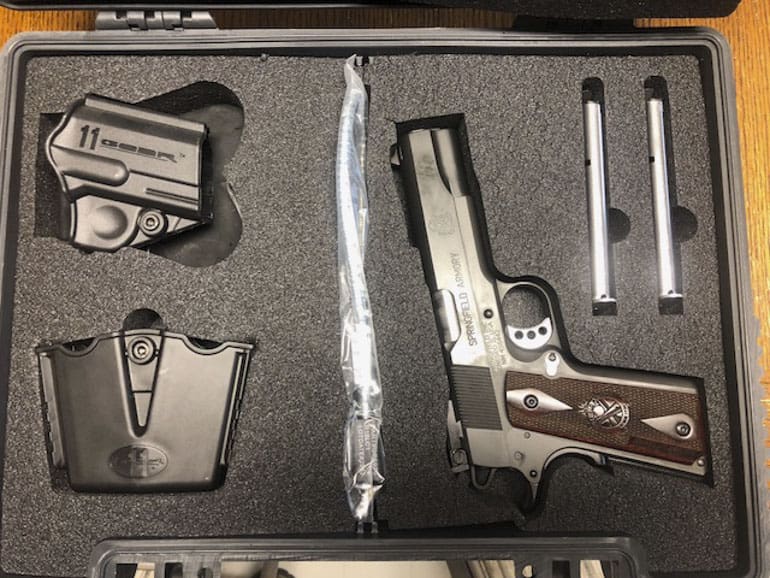
Details
The Springfield Armory Range Officer is an impressive looking package. The pistol comes in a handsome lockable hard case, complete with Springfield Armory polymer paddle holster, polymer double magazine carrier, two 9-round magazines, and a cable lock. The pistol looks great, and comes almost “fully loaded,” to use Springfield’s own terminology.
The Ranger Officer is upgraded from a basic 1911A1 to include a beavertail grip safety, flat mainspring housing, extended single-side thumb safety, skeletonized trigger, flared-and-lowered ejection port, a stainless steel “match” barrel, stainless steel “match” bushing, handsome cocobolo wood double-diamond grips, and excellent adjustable target sights.
Springfield Armory opted for a traditional short recoil spring guide and plug on the Range Officer, as opposed to a full-length guide rod system. The Range Officer comes with a flat matte parkerized finish (more on that below), or it can be had in stainless steel.
Springfield aggressively marketed the Range Officer, and billed it as a competition-ready 1911, without the custom 1911 price tag. From a looks standpoint, SA nailed it with the RO.
Everything about this gun exudes business. It looks like something that the Army Marksmanship Unit turned out for Camp Perry: a no-nonsense, fully set-up target pistol that has everything you need to knock down steel or shoot bullseyes, and no silly additional window dressing.
The Range Officer comes with an excellent adjustable rear sight…
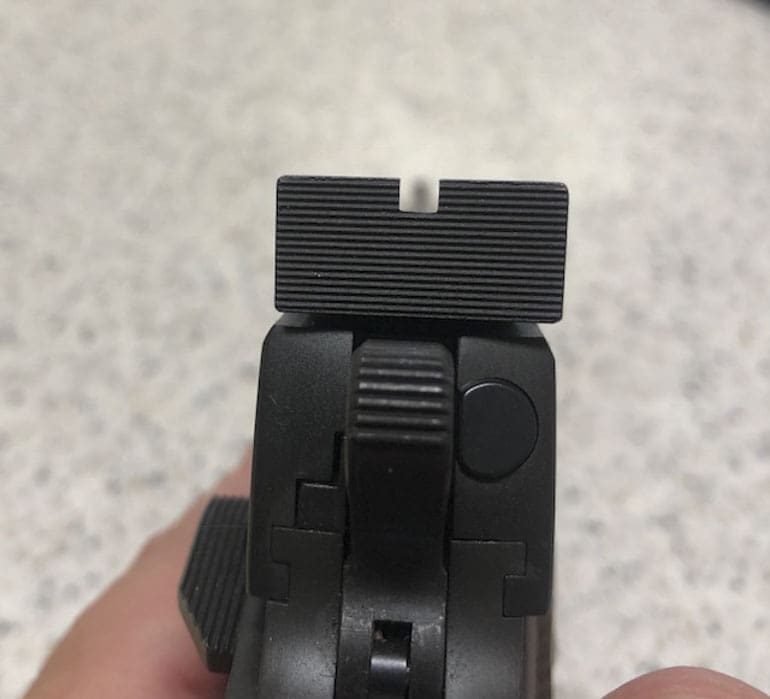
and a crisp, clearly visible front sight.
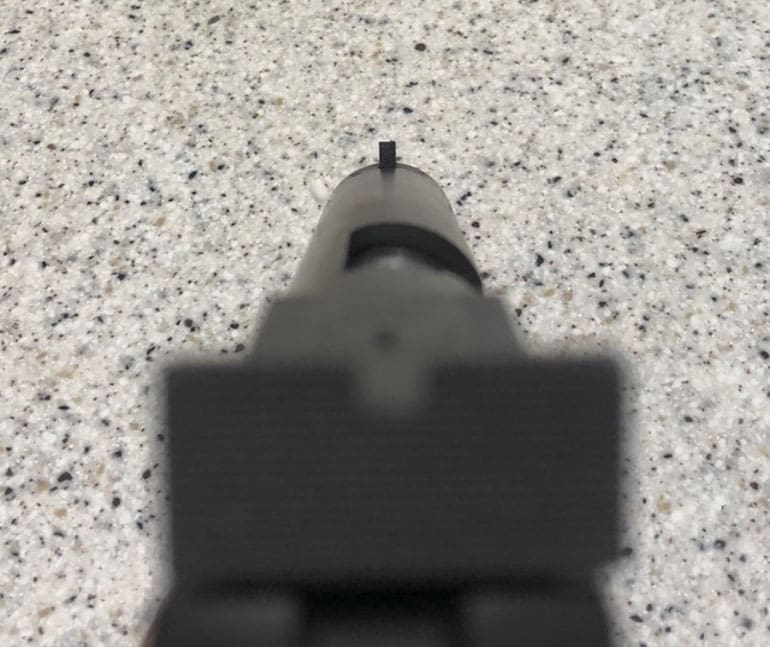
Note that the latest version of the 9mm 1911 Range Officer has a fiber optic front sight (as well as a rail) and MSRP’s for about $100 more than this one.
Brass Tacks
As I said, the Range Officer looks impressive. As Springfield bills the gun . . .
When we introduced the 1911 Range Officer® for the competitive shooter, we were surprised at the response. Serious shooters who care about the details welcomed the precision features that made the Range Officer® perform far beyond its price tag.
However, I had some concerns before I ever shot it.
I’m no expert, but I’ve owned and been around enough 1911s that, to paraphrase Jay-Z, I know a little bit. First, my Range Officer’s grip safety was fitted poorly. Not as bad as others I’d seen, and not that it wasn’t functional, but it was quite sloppy laterally.
Second, the sear spring was weak. I could feel this simply by gripping the pistol and depressing the grip safety. Maybe the grip safety “leaf” on the sear spring could be slightly tweaked to put more spring resistance against the grip safety, but it seems to me that a cheap sear spring is not the place to save money on a 1911, especially one that is billed as “competition-ready.”
A quality sear spring from a reputable manufacturer such as Wilson Combat, Ed Brown, Cylinder & Slide, or Wolff can be had for less than eight bucks. And let’s be honest: Springfield Armory makes a lot of 1911s, some quite expensive. I would expect a manufacturer on this level to install properly specified springs.
Third, the parkerized finish. I get that this finish is economical, and is one of the cost-saving measures used by Springfield Armory to keep the Range Officer’s retail price down, so this one can be forgiven. But personally, I am murder on parkerized finishes because I have sweaty hands.
I’ve owned parkerized pistols (notice the past tense), and I’ve resigned myself to the fact that my parkerized guns have to be Cerakoted because I WILL wear that parkerized finish down to the bare steel, after a fairly short amount of time and handling. Your mileage may vary, but this is a fact for me.
Finally, the trigger. My Range Officer’s trigger is quite mediocre. It has two distinct “stages” before reaching the wall, and a fair amount of creep before breaking. Combined with a 5 to 5 ½ pound pull weight, the Range Officer’s trigger was certainly not what I expect out of a target/competition 1911.
I know, target 1911 triggers require hand-fitting, which raises the cost of the pistol. I get it. But I own a stock Kimber Custom, a similarly set up “factory custom” 1911, that has a magnificent factory trigger in it.
If Springfield Armory was serious about a target/competition-ready 1911, they would spend a little more time on that trigger. Bottom line: it’s impossible to fully realize a pistol’s accuracy potential when that pistol has a poor trigger.
Range Time
Normally, I run a multitude of loads through a pistol when accuracy and function testing. However, I purchased my Range Officer specifically for target shooting, so I opted not to test any hollow point defensive ammunition. This isn’t a pistol that I’m going to carry for self-defense, and I’m not shooting expensive hollow point ammunition at steel and paper targets.
So, I tested four different full metal jacket (FMJ) or plated loads through the Range Officer: 1) American Eagle 147 grain flat point FMJ; 2) PMC Bronze 115 grain FMJ; 3) Blazer Brass 115 grain FMJ; and 4) a hand load consisting of a Rocky Mountain Reloading 115 grain plated bullet propelled by 4.6 grains of Bullseye.
All groups were fired by me at 20 yards, sitting with the pistol resting on a sandbag. A sixth round was loaded into each magazine, to maintain consistent pressure on the bottom of the chamber (if you believe in such things). The results, from best to worst:
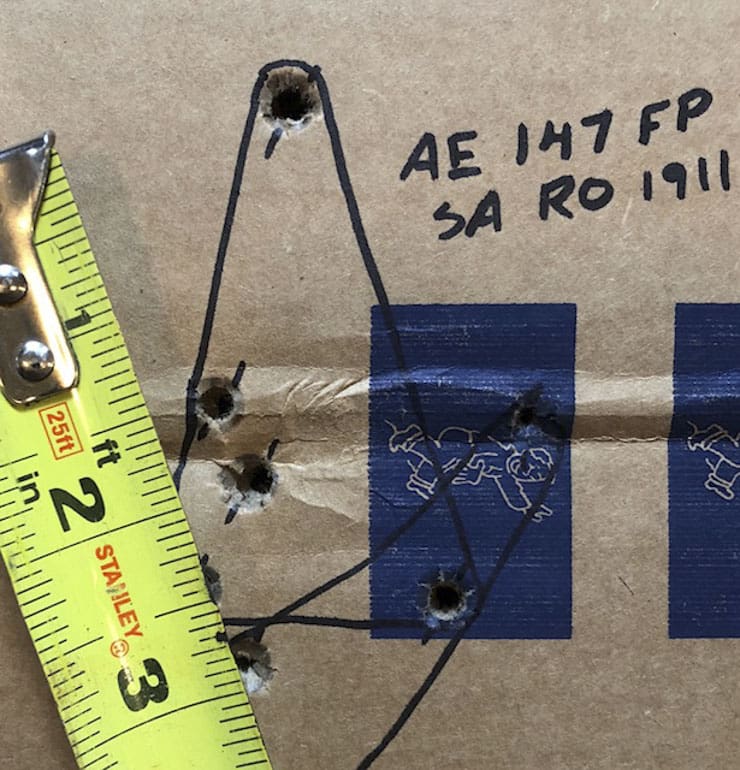
- American Eagle 147 grain flat point FMJ. This heavy-bullet target load put up a 2 7/8-inch five-shot group at 20 yards.
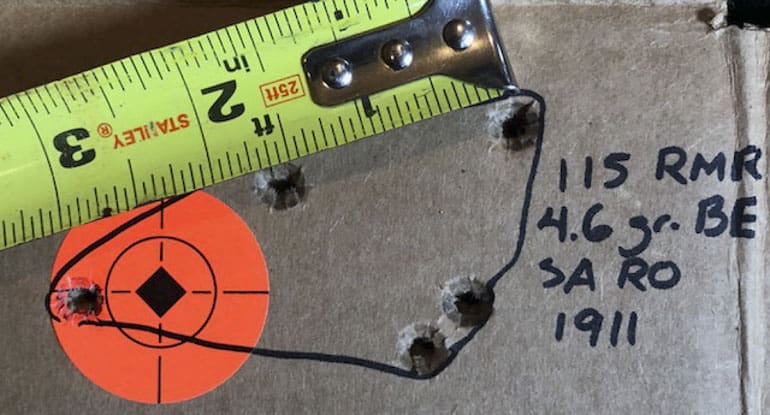
- Handload consisting of a RMR 115 grain plated bullet, 4.6 grains Bullseye. A near tie with the top spot, the author’s bulk reload put up a 3-inch five-shot group at 20 yards.
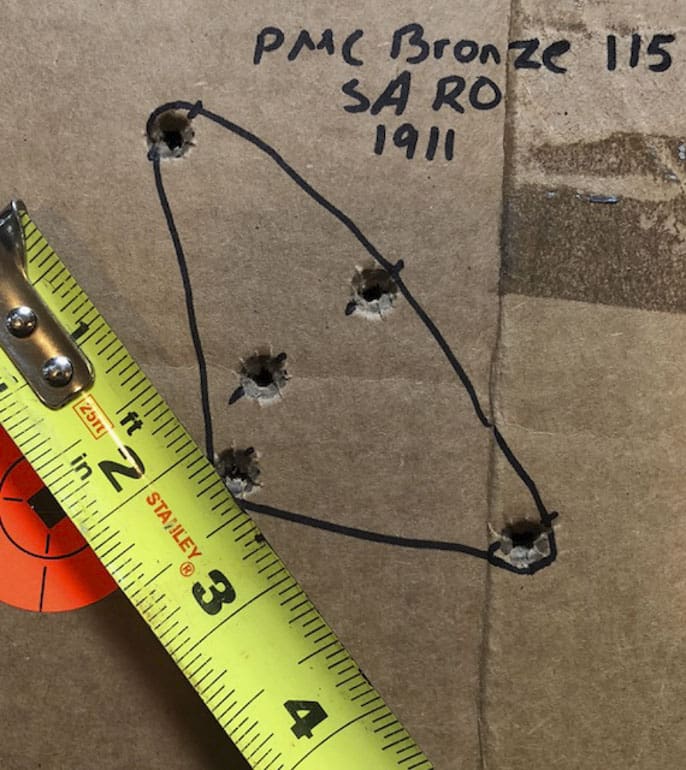
- PMC Bronze 115 grain FMJ. This usually well-performing factory practice load put up a disappointing nearly 4-inch group.
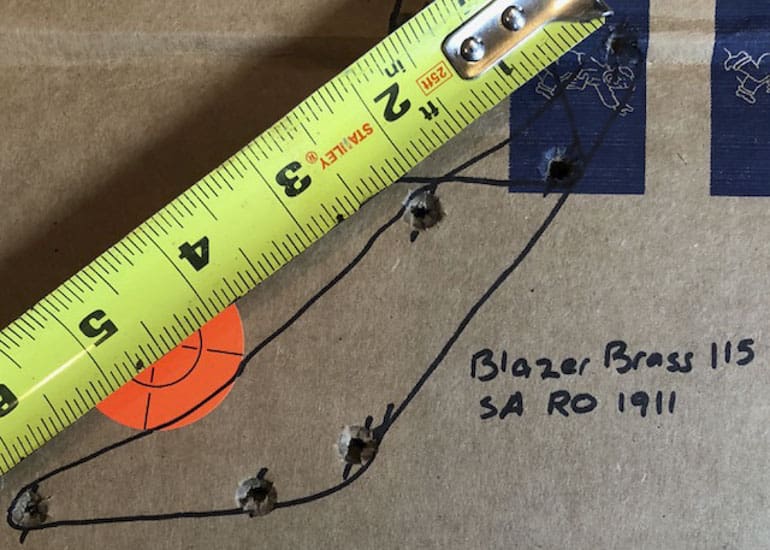
- Bringing up the rear (as it does in EVERY accuracy test I use it in) is the Blazer Brass 115 grain FMJ, with a 6-inch five-shot group. I’ve literally never seen this load shoot a good group, in seven different 9mm pistol tests.
So, in four different practice/target loads, the Range Officer 9mm could barely shoot a sub-three-inch group. This is unacceptable to me for a target/bullseye competition gun, particularly when it’s advertised as such. I’d hardly be happy with this kind of accuracy performance from a duty/service pistol.
I really hoped to see neat, tight sub-two inch (or better) groups out of the Range Officer, a pistol billed as having a “match” barrel and bushing. But I’m pretty sure I could beat these groups with my GLOCK 19.
Accuracy testing pistols is all relative, and you have to compare apples to apples. I’m willing to accept 3-4 inch groups at 20 yards from a defensive or duty pistol. Those types of pistols are mass-produced and designed for reliability, often at the expense of tack-driving accuracy.
Generally speaking, service pistols only need to shoot minute-of-bad-guy at longer distances.
But I’m not willing to accept such performance from a pistol that bills itself as a competition/target pistol, as the Range Officer does. It was foolish of me to expect tack-driving accuracy from a sub-$1,000 1911. I know better. That kind of performance requires hours of hand-fitting, which adds to the cost of the pistol.
I give Springfield Armory credit: they hit a home run in marketing the Range Officer, and they sell a boatload of them. But don’t kid yourself: you’re not going to buy a Range Officer and be competitive at a bullseye competition (assuming you have the requisite skill).
I’ll use a car analogy: if a Wilson Combat/Ed Brown/Les Baer/Nighthawk 1911 is a Ford Mustang Shelby GT350, the Range Officer is the Ford Pony. From the outside, the Pony may look like the Shelby, but that V-6 under the Pony’s hood simply can’t compete with the Shelby’s big V-8.
SPECIFICATIONS: Springfield Armory 1911 Range Officer
Caliber: 9mm
Sights: Fully adjustable black target front and rear
Weight: (with empty magazine) 41 oz.
Length: 8.6″
Height: 5.5″
Slide: Forged carbon steel
Frame: Forged carbon steel
Barrel: 5″ stainless steel match grade, fully supported ramp
Grips: double diamond cocobolo
Magazines: two 9-round
MSRP: $945 (about $899 retail)
Ratings (out of five stars):
Ergonomics * * * * *
Nothing feels more natural in my hand than a 1911. All controls are where I want them, and they are completely second nature to me. Some users prefer ambidextrous thumb safeties; I’ve carried a 1911 enough that I’m not one of those users. I would prefer front strap checkering and an undercut trigger guard, however both of those are niceties that would add to the price tag.
Cosmetics * * * *
The Range Officer looks great. The rollmarks on the slide aren’t too “billboard-y”, and there is nothing to upset the sublime lines of John Moses Browning’s masterpiece. The nicely-executed wood grips compliment the gun. I only deduct a star because of the dull, flat, parkerized finish.
Accuracy *
Again, accuracy is relative. Were this a service pistol, I probably would have been more forgiving and given it more stars. But I’ve shot multiple 9mm service pistols that deliver better accuracy than the Range Officer. I also own a few other similarly priced 1911s from competitors, chambered in .45ACP, that outshoot the Range Officer. To me, if you are going to market a pistol as a target and competition pistol, it had damned well better be accurate. And 3 to 6-inch groups don’t cut it. I’m at a stage in my handgunning career where I know I can shoot better than my Range Officer is capable of delivering. And that makes shooting the Range Officer no fun.
Trigger * *
Again, were I reviewing a 1911 intended for defense or service duty, I’d be more lenient. But for a pistol advertised for competition, the Range Officer’s trigger is sadly lacking. Stagey, creepy, and a heavier pull weight than should be in a target 1911 make shooting this pistol accurately difficult. Aside from the barrel build and lockup, the trigger is the most important ingredient in a firearm’s accuracy. Bottom line: if the trigger sucks, you can’t shoot it accurately.
Reliability * * * * *
I had no reliability issues with the Range Officer at all. Granted, I have only put a few hundred rounds through it, and no hollowpoints. I have no notion of how/if the original owner broke the gun in, but from the looks of the pistol and discussions with him, I would say not.
Overall: * * * ½ Stars
I was disappointed in my Range Officer 9mm. I had really hoped Springfield Armory would deliver on its promise of a no-frills, all business, full-size 1911 ready for competition and target shooting out of the box. But the Range Officer is not that pistol. Colonel Townsend Whelen said that “only accurate rifles are interesting.” That goes for pistols too. And the Springfield Armory Range Officer is definitely not interesting.


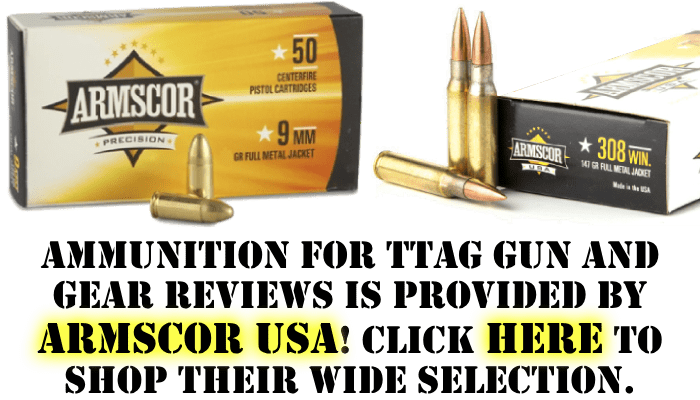



Springfield armory could make the best gun in the world and I would never one. I hope they fail and shutdown.
Agreed, wouldn’t catch me shooting one at my local rang.
That might be TTAG’s new “Soy based Morality Filter” distorting words and there mean.
+1. Sic semper proditoribus.
So, an overpriced POS. Lots of hype and little performance. What else would one expect from Springfield Armory? Didn’t they make their attitudes clear a couple of years ago? Sponsorship talks, and their customers can go suck eggs.
I’d recommend a VIS35 if you want a 9MM 1911.
It’s pretty shitty to wish that on all of those people working there. They don’t call the shots, and they’re just trying to make a living like everyone else.
I hope levi’s fails too. Same with Dicks Sporting goods. I’m sure there is a big list somewhere.
Well, when you put it like that…I haven’t been to Dick’s since they lost their mind, and I don’t plan on going back. I haven’t bought Levi’s in over 20 years anyway, so that one’s easy. I’ve forgiven Springfield because I feel like they changed instead of doubling down like Dick’s and Levi’s. Plus, Springfield made an immediate statement about Dick’s by pulling their products from the store.
And here we with the I hate Springfield posts. If you hate Springfield, STFU and don’t buy their products. We don’t need to here about over and over again.
You sound smart :p
You sound stupid.
You sound gay
You sound unwoke.
You all need to be taken to Detroit.
https://youtu.be/Ny4a-oxOndo
*hear
You might not need to hear it, but there are lots of new readers. Someone who wasn’t following a couple years ago wouldn’t know about the action of Dicks, SA, Rock River (not Island), etc. Some people don’t like Troy because they hired Lon Horiuchi, which other people was “Who? What’s about it?” If someone thought that was important and wanted others to be informed in order to spread the boycott, it would be good for them to bring up. It’s inappropriate to spam it on every article, but since it’s an SA article, bringing up their misdeeds seems relevant.
honest review.
not a very good analogy though. it would help if the high end guns referenced were in .45. then the v8/ v6 thing begins to make sense. maybe rack and pinion/ recirculating ball…
My Range Officer 9mm had even worse accuracy issues. Groups with various 115 grain FMJ 9mm factory loads were typically 7+ inches at 25 yards! It shot better with 147 grain loads, getting down to sub 4 inch groups. But when my Ruger LC9 can produce 3 inch groups at 25 yards with 115 grain WWB-grade ammo, the Range Officer 9mm has absolutely no excuse for its accuracy issues. I even sent the Range Officer 9mm back to Springfield for them to look for any problems that might be causing the accuracy issues, and they sent it back with no work done to it.
Sadly when bagged I would think my $300 SD9VE could do that.
“Rang” Officer, never heard of it.
Spell check will only get you so far without proofreading
Exactly.
Wasn’t Quasimodo a rang officer?
Yeah til his house burned down
I had the stainless version that wasn’t bad out of the box. It was even better after I gutted it and replaced and tuned almost every internal part with Wilson Combat parts. For whatever reason I can’t hold onto a 1911 and sold it to a buddy of mine.
For just a bit more, a Dan Wesson Valor in 9mm is the bomb. Yes, it’s discontinued but a great pistol just the same!
I am very very pleased with my Dan Wesson Pointman 9.
A sub $1500 gun with a lot of Ed Brown parts inside.
Obviously built for metallic target shooting down south or in Tejas. So you can hear that steel “rang” every time you pull the trigger.
i have one of these and im very happy with it, i cleaned up the trigger channel and polished all the internal parts and did a very limited trigger job 3.5 pounds as i use this as a carry gun sometimes. i also installed a one piece guide rod,
with my reloads 124 gr it will shoot 2.25″groups at 25 yds from a ransom rest.
im very happy with ikt for a $750 gun new with 3 mags and holster.
i will agree with the parkerise finish. i love a well polished blued gun. it could be worse though it could be painted/tech coat or whatever they want to call the sprayed on finish to try to convince the customer its not paint.
you want to talk junk lets talk about the taurus loaded 1911.for $75 less i had to replace everything but the slide frame and bbl.over $250, i had to clean up the machine cuts in the frame with a dremmel to get the gun to function. taurus wanted $50 shipping to fix a brand new unfired gun.
my point is perspective! in its price point the RO is a very nice gun that will need little work to out preform most shooters. its not fair to compare it to a nighthawk or wilson combat and other premium pistols regardless of what they call it.
I had one and the problem I had with it was that it through just about every piece of brass right in my face and I developed a flinch. Got rid of it. Probably my worst buy for a pistol and I still like Springfield.
STFU you can like SA, we just dont want to hear about it.
Some kinda fanboi.
Wtf is a Ford Pony. The reviews on this website border on asinine almost every time.
Btw there are plenty of sub $1000 1911 tack drivers.
you could drive spikes with this thing.
Define “tack driver.”
From my perspective, a 1911 “tack driver” should be able to achieve a five-round group of 2″ or less at 50 yards with match ammo off a rest.
That’s a pretty good definition by my book.
I have a pre-war K-22 Outdoorsman that I (even I) can drop 10 in an inch at 50.
I can do under 2 with my model 15 and 57 as well.
4 inches at 25 seems to be “acceptable” accuracy nowadays.
Ah, what did one of my relatives say, “Real men use .45 ACP in their .45 ACP 1911….”
Parkerized finished can be quite resistant to rust, water, etc.
You have to wipe them down with oil. The park’ed finish will take up oil. Wipe it down with oil – use a bunch of oil, and just wipe off the excess. That’s what a park’ed finish is for: retaining oil. Sure, it’s cheaper than a nice blue job – but it also holds oil on the finish better than blueing. When the oil dries up, you put on more oil.
As for the rest of the review: I keep putting prices on what a good gun, with attention at the factory by skilled hands, should cost. I keep naming numbers with four digits. People keep telling me that I don’t know what I’m talking about. People keep doing reviews of guns that prove they’re not getting what they want in the three-digit range. I keep telling people that their money has been made worth less by the policy of the Federal Reserve when you attempt to buy anything tangible with it.
This is just one more data point.
I, too, miss the wild swings in dollar value from the pre-Fed days.
https://www.officialdata.org/assets/img/US_Historical_Inflation_Ancient.svg
You miss the significance of the part of the graph “below the line” there.
During the times that the graph showed green? Your money’s buying power increased, offsetting some or most of the inflation devaluation in blue in earlier parts of the business cycle.
When you look at the since 1947 or so, what don’t you see? You see no part of the business cycle where the dollar appreciates in value again. The Fed decided that they never wanted to see deflation again, so they have a deliberate campaign of keeping inflation around 2%. That’s their stated inflation target – devaluing your money deliberately, slowly, and without reversal, every single year.
The only thing that happens to the dollar now is that it loses value – either quickly, as in the late 70’s, or slowly, as now. There is no countervailing deflation that increases the buying power of the dollar again.
And that’s what you see in gun prices, car prices, home prices, etc. When you want to buy anything tangible with the dollar, you’re going to pay more for it. Whereas you could buy a car when I was a kid for $3K, today you’re going to be looking at $25 to $30K to buy a car. Gun prices also have to go up, but the gun industry has stripped out the value in guns for decades now, trying to maintain sub-$1K prices.
The Fed was created, allegedly, to be the “Bagehot lender” of last resort: “Lend freely, at high rates” was the thought for a lender of last resort in times of debt deflation. The Fed has failed at even that role, instead propping up reckless decisions by the financial sector and allowing incompetent people to take on ever more risk.
That’s all correct, although the broad understanding is that deflation is damaging to the economy – everything essentially going on sale reduces purchases of durable goods and makes manufacturing difficult. Imagine getting progressively fewer actual dollars for your product, while trying to manage purchases of raw goods that go in, and also reducing pay rates for staff to accommodate the deflating currency.
The benefit of a low inflation is that it requires wealthy people to invest rather than sit and hold. It does slowly eat at savings, but that hurts and moves a Zuckerberg in ways you and I don’t feel. Also, it means that money will move through small businesses with increasing velocity, which is much easier to manage than reducing velocity. And no one is going to consider timing the currency around the sort of large purchases that tend to be the focus of better paying jobs.
But no, we shouldn’t be bailing out failed banks, even if the failure stems from congress playing with loan standards.
Good honest opinion.
Thanks Austin Knudsen.
Yet another 1911 review by a gun snob. My first pistol was a 1911, I qualified with a 1911 in the Army, I was issued a Kimber 1911 while on contract in Iraq, and my wife and I each own a 1911 now among our many other pistols and really I don’t see where this guy is coming from. Frankly, they have all been about the same to me and our ATI 1911’s work and shoot just as well as the Kimber I carried in Iraq did. And this guy needs some medical attention if his sweaty hands take the Parkerizing off after a few hours of use.
And how about a little proofreading, editor? “Rang” officer? Really?
Not a snob. If you look on this site, I actually review affordable (read as “cheap”) guns. I agree it is possible to get a decent affordable 1911: I own a couple. But the Springfield Range Officer is not one of them.
$400 pistol
SA can rot.
And how long are you going to leave “Rang” in the title?
Kinda sad.
Guys. I didn’t write “Rang.” It’s an editing mistake when it was posted. It happens. These guys are busy.
Austin! Wish I’d read your review 2 months ago. I did my 20, spent some time with the Army MTU, retired (20+ years ago) and missed competing, went the USPSA route, SS Major with a Gold Cup Trophy Model. A gazillion rounds later arthritis came to visit and my right thumb went to glory… All that to say I’ve been feeling guilty about the extras I sunk into my 9mm Range Officer that was only sorta competition ready (stainless steel btw) just so I can keep competing! Full length guide rod, trigger job, EGW Ignition kit, Wilson combat mag release, and some other tidbits. And bless it’s heart, it runs like a striped ass ape. 124gr white box Winchester, all day long. I figure I’m still $4,000 less than I’d have sunk into any of the “race” guns.
Holster wear and normal usage took the parkerizing off my 1980 Colt Model 70 – I think the civilian version is not the same as the original military finish; I don’t think it’s you sweating it off!
The 1911 is for experienced and willing gun owners. They demand patience, parts, labor and time to get right in the price range of the range officer
Anyone that buys into ” competition ready” deserves what they get. A good 1911 is a beautiful thing and expensive. There’s a reason glock sells so many pistols.
If all you guys hate the 1911 and springfield so much , well that’s just what the left needs ie, for us to be divided.
Flame on. I’ll continue to shoot my 1911s and P-35s.
The good news is, my girlfiend can shoot those same size groups with her HiPoint
I would have liked to have seen the smaller group with you G19 just to prove it. Not saying you are lying about getting better groups with the G19, just that it would be more damning for the Range O. Otherwise, it’s just speculation.
Guys, the Range Officer is not fitted any differently than the standard Loaded model. There is no custom work or hand fitting with a these guns. I spoke with Springfield Armory at the 2018 NRA Convention, and when I started asking detailed questions around the Range Officer and if it receives any different fitting than the Loaded, I was told no… that it’s all marketing flash. I have seen many Range Officers fitted very poorly, including the slides proud of the frame more than what is acceptable.
If you want a 9mm tack driver that will cost a bit more but will still remain under $2k, look at the Dan Wesson Pointman 9 or the Sig P210 Target. Flame me if you want about the P210 Target not being a real 210, but it’s a darn accurate shooter.
When it comes to 1911s, there IS a big difference in quality from low end to even mid tier manufacturers. It’s not snobbery, it’s the truth. When you pay more for better fit and better quality, you will notice the difference in group size at 50 ft and beyond. If you don’t, that’s typically on you.
I shot a modern P210 this spring. I was suitably impressed by the groups it laid down.
While I still hanker for an original Swiss production model, I would not turn up my nose at the modern P210, and in the future, I might very well get one. Tho, I have to say, that getting a S&W Model 52 is higher on my priority list.
DG- I’ve lusted over a S&W 52, or even a 952, for years. I’d love to see what one of them will do. As always, appreciate your insight and comments.
I have observed that the fit and finish of the SA RO is acceptable for a low tier production 1911. The problem with these is the barrels. The springfield 9mm 1911 barrels are machined way outside of SAAMI specs in the leade section. Result is inherent inaccuracy. Only solution is barrel replacement with an aftermarket barrel. Logical action is to distrust Springfield armory 9mm barrels.
I know, but I don’t know, about all “that”. I have a ‘Loaded’ SA .45 and Love it.
I’ll say this, you live on the West Coast, you know the lunacy. If the horde comes? I feel perfectly comfortable knowing my SA will hit -real- tight in a torso sized target when I need it. And it will do it again , and again, and again. Just be happy you got a firearm that you can count on to go bang. Better than stuffing a shotgun shell in a pipe and hitting it with a hammer and a nail. Worrying about what’s “correct”… Jesus.
Hmm… accuracy testing…20yds off a sandbag. Very sophisticated. My old but small gun club has its 2nd in 30yrs, new Ransom rest. They just dont cost that much.
Too bad looks nice but I’ll die before spending a penny with SA or RRA. You conspired against the Illinois gun owner for your own carve out. Now look what a mess IL is in, glad I left IL for a free state. Decisions have consequences anyway aren’t all your guns out sourced from Brazil and Croatia anyways?
9mm goes with 1911 as 351Cleveland goes with Prius. Stupid.
Hmm… lots of emotion in the comments section, Isn’t anyone curious to understand actually WHY these SA 9mm 1911 pistols are this inaccurate? I certainly am, because I recently purchased a RO operator in 9mm. The barrel fit up is excellent the slide to frame fit is excellent, the feed reliability is excellent. But… wildly inconsistent groups of 2-4″ at 15yd bench rested… So what is going on with these? I am confident I have figured it out: Remove your barrel and look into the chamber. The part of the barrel just past the head space ledge is where the leade is cut into the barrel. This is a chamfer reamed out of the barrel to provide clearance for the bullet so that you can chamber a round with a normal range of OAL. The industry standard dimensions for this are published by SAAMI. These springfield 9mm 1911 barrels have the leade section reamed out WAY outside of SAAMI specs. I measured mine, the leade angle is approx 0.85 deg versus the SAAMI specified 2 deg. Result, the leade section is cut excessively deep into the barrel which results in too much clearance for the bullet. In a normal SAAMI spec 9mm barrel, the bullet will make contact with the riflings while the butt of the bullet is still inside the brass case. These SA barrels are excessively reamed out so much that the bullet does not make its first contact with the rifling until after it has completely exited the brass case and even jumped a small gap. That’s right folks… I have now observed this dysfunctional chamber geometry in a sample of 3 of these SA 9mm barrels. This is easy to check. Take a plain bullet, say 124gr with no case and drop it in the chamber. In these sloppy SA 9mm barrels the thing drops in so far that the butt of the bullet is past the headspace ledge. Drop the same bullet into a SAAMI spec barrel and you will find the bullet stops on the rifling with a substantial portion of the butt of the bullet protruding into the chamber space. So, every time you fire this pistol the bullet spans a gap and contacts the barrel rifling in small randomly altering positions with every shot. The only way to fix this is to replace the barrel with a quality hand-fitted after market barrel which is exactly what I plan to do with my RO. Springfield just recently discontinued the RO line and has dramatically reduced the number of 9mm 1911 offerings in their product line. It’s too bad because they make excellent 45ACP barrels. It appears that they released a massive quantity of these bad 9mm barrels into the market and advertised them as competition ready target pistols. I made a warranty complaint, SA says this level of accuracy is normal. But the gunsmith did offer to replace my barrel. I declined because it does me no good to replace a bad SA 9mm barrel with a new SA 9mm barrel with the same problem. No, I will take matters into my own hands and hand fit a good SAAMI spec barrel and turn this baby into a tack driver. So look for yourself, if you have a SA 9mm 1911 barrel, inspect the leade section of the barrel, easiest way is to drop a plain bullet into the chamber with no case and see how deep it drops in. I have explained this observation to Springfield Armory in emails and they are not responding.
Gear up as your favorite Delsin Rowe Vest. Slim Fit Leather Jackets brings this iconic jacket from animation to reality, especially for all the fans of this video game. Delsin Rowe is the main protagonist and playable character, a young Native-American man who later realizes he’s a Conduit with special powers.
Comments are closed.